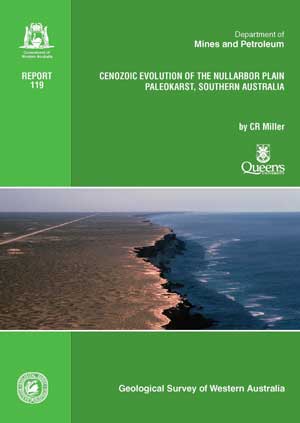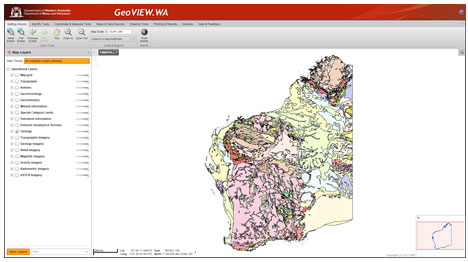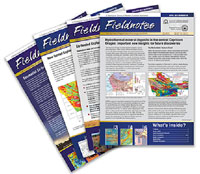Latest releases
REPORT
Report 119 Cenozoic evolution of the Nullarbor Plain paleokarst, southern Australiaby Miller, CR

The Nullarbor Plain in southern Australia is an uplifted succession of Cenozoic marine carbonates whose surface has been exposed for ~14 m.y. This succession of limestones, particularly in the surfical middle Miocene Nullarbor Limestone, hosts a complex and prolonged record of meteoric diagenesis. Alteration took place through 3 broad phases of diagenesis encompassing 8 stages that are interpreted to have taken place over a dramatic regional climate change.
Phase 1 diagenesis occurred under a humid middle Miocene climate and involved mineralogical equilibration with meteoric fluids, calcite cementation, widespread microkarst, and regional lacustrine and palustrine sedimentation producing copious amounts of ooids. These ooids are interpreted to have formed via microbial secretions and sediment aggradation over multiple seasons of changing rainfall and soil hydration states. Cortical laminations are proposed to represent microbial mucus envelopes during wet seasons alternating with dehydration during dry seasons and precipitation of fibrous clay minerals and CaCO3 that preserve the pre-existing microbial fabrics.
Phase 2 alterations took place under a more temperate climate from the late Miocene to Pliocene with a later pronounced humid interlude. This phase encompassed ~8 m.y. and was dominated by karst process where deep cave dissolution occurred at depressed water tables related to globally low sea levels and later shallow caves developed during a Pliocene sea level highstand.
Phase 3 has occurred since the late Pliocene and is indicative of the onset of modern semi-arid climatic conditions. This final phase involved the creation of subsoil hollows filled with blackened limestone lithoclasts, deep and shallow dolines, and indurated pedogenic calcrete that now forms much of the surface of the Nullarbor Plain. Blackened limestone clasts have been shown to form at the B-C boundary in soil profiles where roots have their cellular structures calcified and during this process incorporate trapped organics that ultimately produce the distinctive black colouration. The importance of this comprehensive diagenetic record is its direct applicability to the understanding of ancient subaerial exposure surfaces.
Products are free to download from our website as PDFs.
New GeoVIEW.WA training – sign up now!

You are invited to attend a free training session hosted by the Department of Mines and Petroleum to demonstrate current online systems. This is your opportunity to try these services for yourself and chat with the staff who create and manage them.
The format is an interactive presentation which includes navigating the DMP website, searching for publications, finding mineral deposits using MINEDEX, finding digital datasets using the Data and Software Centre, open file mineral exploration reports using WAMEX, and bringing it all together with the interactive map viewer (GeoVIEW.WA). GeoMap.WA, a new GIS viewer for Windows, will also be demonstrated.
The morning sessions will be a high-level fast demonstration and overview of the use of all the programs. At the afternoon sessions, participants will be able to practise using the programs with their own actual examples and get some one-on-one advice about individual issues. You can attend one or both sessions.
Perth
Mineral House training room
9 am – 12 noon, 2–5 pm – Wednesday 7 November – one place left
9 am – 12 noon, 2–5 pm – Friday 9 November – places available
Kalgoorlie
WA School of Mines, Mine Design Lab, Room 131, Building 703, Odwyn Jones Building, corner Cassidy and MacDonald Streets, central Kalgoorlie.
9 am – 12 noon, 2–5 pm – Wednesday 14 November– places available
To register, email your details to publications@dmp.wa.gov.au.
Access GSWA products
You can download maps, reports, and digital information free of charge from our website.
Click on these links to take you to the download page for that product:
- Geoscience information, maps and reports
- GIS versions of maps
- Interactive geological map (GeoVIEW.WA)
- Promotional flyers and posters
- GeoMap.WA GIS software
- Mineral deposits and mine information (MINEDEX)
- Mineral exploration reports (WAMEX)
- Petroleum and geothermal information (WAPIMS)
- TENGRAPH online
- Airborne geophysics index (MAGIX)
- Geochronology
- Geochemistry (GeoChem Extract)
- Petroleum Geothermal Register (PGR)
Hard copies
Hard copy publications are also available to purchase from the eBookshop or the First Floor counter at Mineral House, 100 Plain Street, East Perth, WA 6004.
Subscribe to Fieldnotes

Fieldnotes is a quarterly publication released by GSWA to provide the State's exploration industry and other geoscientists with an update on our latest work and ongoing programs. The publication provides updates on other GSWA products and services and is available free from the Information Centre located on the first floor of Mineral House, 100 Plain Street, East Perth 6004. Find past issues of Fieldnotes here or subscribe to receive a hard copy by emailing publications@dmp.wa.gov.au.
Contact us
For information on publications, email publications@dmp.wa.gov.au
or telephone +61 8 9222 3459/ fax +61 8 9222 3444.
For information on digital data, email the Digital data administrator on gsd.dda@dmp.wa.gov.au
or telephone +61 8 9222 3816.
Physical address
Mineral House
100 Plain Street
East Perth WA 6004
www.dmp.wa.gov.au/gswa
For more information about GSWA and its products, go to the GSWA website.